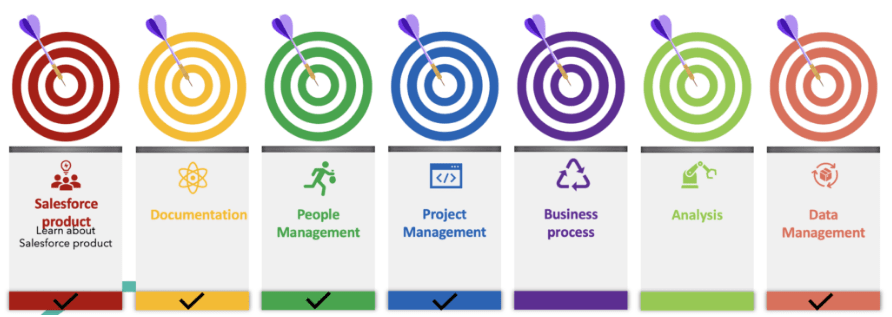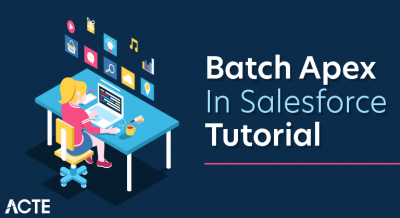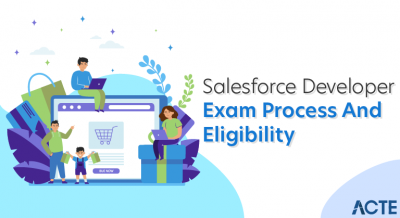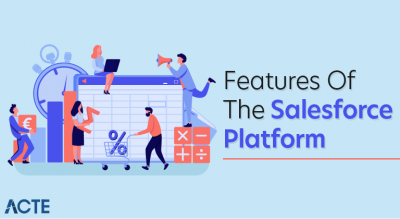
- Introduction to Salesforce Business Analyst Role
- Key Responsibilities of a Salesforce Business Analyst
- Required Skills and Qualifications
- Gathering and Analyzing Requirements
- Creating and Managing User Stories
- Collaborating with Developers and Admins
- Data Modeling and Report Analysis
- Documentation and Process Mapping
Introduction to Salesforce Business Analyst Role
A Salesforce Business Analyst (BA) plays a pivotal role in aligning business objectives with Salesforce capabilities to drive efficiency and value. Acting as the liaison between stakeholders and technical teams, a Salesforce BA is responsible for gathering, analyzing, and documenting business requirements. They work closely with users, managers, and executives to understand operational challenges, identify opportunities for improvement, and propose Salesforce-based solutions that support strategic goals. One of the core responsibilities of a Salesforce BA is to optimize business processes through effective use of the Salesforce platform. This involves conducting interviews and workshops, mapping current workflows, identifying pain points, and recommending enhancements, including Salesforce Training. They translate business needs into user stories or detailed specifications that developers and administrators can act upon, ensuring that solutions are both technically feasible and aligned with business expectations. Salesforce Business Analysts also play a key role in system testing, user training, and change management to ensure smooth implementation and adoption. Their insights help prioritize features, streamline sales and service processes, and increase user engagement with the platform. By bridging the gap between business and technology, Salesforce BAs help organizations maximize the return on their Salesforce investment. They contribute directly to improving productivity, enhancing customer experiences, and enabling data-driven decision-making across departments. Their strategic input ensures Salesforce is not just a tool, but a tailored solution that supports long-term business growth.
To Explore Salesforce in Depth, Check Out Our Comprehensive Salesforce Training To Gain Insights From Our Experts!
Key Responsibilities of a Salesforce Business Analyst
The key responsibilities of a Salesforce Business Analyst (BA) revolve around understanding business needs and translating them into effective Salesforce solutions. One of their primary roles is to gather and document detailed business requirements through stakeholder interviews, workshops, and process analysis. This involves working closely with various departments such as sales, marketing, service, and operations to identify pain points, inefficiencies, and opportunities for system enhancements, including understanding the Types of Flow in Salesforce. Once requirements are defined, the Salesforce BA collaborates with developers, administrators, and solution architects to design and implement appropriate solutions within the Salesforce ecosystem. They create user stories, process flows, and acceptance criteria to guide the development team and ensure alignment with business goals. In addition, Salesforce BAs are responsible for conducting gap analyses, mapping current and future-state processes, and identifying areas where automation or new features can improve productivity.

They also play a key role in testing solutions, developing training materials, and supporting user adoption through change management initiatives. Monitoring the success of implemented solutions is another critical responsibility. Salesforce BAs use data and feedback to assess performance and recommend continuous improvements. Ultimately, a Salesforce Business Analyst serves as the bridge between business users and technical teams, ensuring that Salesforce is configured and optimized to support business strategy, improve efficiency, and enhance the overall user experience.
Required Skills and Qualifications
- Strong Analytical Skills: Ability to assess business needs, interpret data, and identify process improvement opportunities within the Salesforce ecosystem.
- Salesforce Knowledge: Solid understanding of Salesforce features, objects, relationships, and capabilities (Sales Cloud, Service Cloud, Reports, Dashboards, Flows, etc.). Salesforce certifications like Salesforce Administrator or Business Analyst are highly desirable.
- Effective Communication: Strong verbal and written communication skills to collaborate with stakeholders, document requirements, and relay technical information in a clear, non-technical manner, including explanations of Salesforce Sandbox Explained.
- Requirement Gathering and Documentation: Proficiency in collecting, organizing, and documenting user stories, business requirements, and process flows using tools like Jira, Confluence, or Lucidchart.
- Problem-Solving Ability: Skilled at identifying challenges, evaluating alternat ives, and recommending Salesforce-based solutions that align with business goals.
- Project Management Understanding: Familiarity with Agile, Scrum, or Waterfall methodologies to effectively support project planning, sprint execution, and backlog prioritization.
- Attention to Detail and Critical Thinking: Ability to analyze complex processes, foresee potential impacts, and ensure completeness and accuracy in every phase of the solution lifecycle.
- Engaging Stakeholders: The BA begins by identifying and involving key stakeholders across departments to understand their needs, expectations, and pain points related to current business processes.
- Conducting Discovery Sessions: Through interviews, workshops, surveys, and observation, the BA collects detailed information about how teams operate and what improvements they seek in the Salesforce system.
- Documenting Business Needs: The information gathered is translated into structured documentation, such as Business Requirement Documents (BRDs), user stories, and use cases, including details related to Salesforce Training, providing clarity and alignment for the technical team.
- Clarifying and Prioritizing Requirements: The BA works with stakeholders to distinguish between must-have, nice-to-have, and future-phase requirements, ensuring the most valuable features are addressed first in development.
- Creating Process Maps: Visual process flows are developed to represent both current (“as-is”) and future (“to-be”) workflows. This helps identify inefficiencies, redundancies, and opportunities for automation or system improvements.
- Performing Gap Analysis: The BA compares current capabilities with desired outcomes to identify functional or data gaps that need to be addressed in the Salesforce solution.
- Validating Requirements with Stakeholders: Before moving forward, the BA reviews and confirms all gathered requirements with stakeholders to ensure accuracy and completeness, reducing the risk of scope changes later in the project.
- Testing and Validation: The BA participates in functional testing or supports user acceptance testing (UAT) to confirm that the solution meets business needs before it goes live.
- Providing Feedback and Iteration: BAs gather feedback from users and relay it to the technical team, helping iterate and refine solutions during development cycles.
- Ensuring Best Practices: BAs work with technical teams to apply Salesforce best practices, ensuring data integrity, security, performance, and long-term maintainability of the system.
- Translating Business Requirements: The BA converts business needs into clear user stories or functional requirements that developers and admins can act on, ensuring the solution aligns with user expectations.
- Facilitating Communication: Regular interaction between the BA, developers, and admins helps maintain alignment through meetings, stand-ups, and sprint reviews, reducing misunderstandings and rework.
- Clarifying User Stories and Acceptance Criteria: BAs ensure each user story includes detailed acceptance criteria so the technical team knows exactly what needs to be built and how success will be measured, particularly when defining the Sales Process in Salesforce.
- Supporting Solution Design: BAs collaborate with admins to propose point-and-click solutions and with developers when custom coding is needed, helping choose the most efficient and scalable approach.
Would You Like to Know More About Salesforce? Sign Up For Our Salesforce Training Now!
Gathering and Analyzing Requirements

Creating and Managing User Stories
Creating and managing user stories is a fundamental responsibility of a Salesforce Business Analyst, ensuring that business requirements are clearly communicated to development teams. A user story is a short, simple description of a feature or function from the end user’s perspective. It typically follows the format: “As a [user], I want [goal] so that [reason],” which helps keep the focus on user needs and business value. The Salesforce BA works closely with stakeholders to gather requirements and then translates them into well-defined user stories. Each story should be concise, actionable, and include acceptance criteria that define what success looks like. This clarity helps developers and administrators understand exactly what needs to be built and tested, especially when integrating Amazon Web Services Salesforce solutions. Once created, user stories are organized and prioritized in a product backlog, often using tools like Jira, Azure DevOps, or Salesforce’s own Agile Accelerator. The BA collaborates with product owners and scrum teams during sprint planning to refine stories and ensure they are ready for development. Throughout the project lifecycle, the Salesforce BA monitors the progress of user stories, facilitates feedback, and updates requirements as needed. Effective user story management ensures alignment between business goals and technical delivery, resulting in better solutions and higher user satisfaction.
Do You Want to Learn More About Salesforce? Get Info From Our Salesforce Training Today!
Collaborating with Developers and Admins
Data Modeling and Report Analysis
Data modeling and report analysis are essential functions of a Salesforce Business Analyst, enabling organizations to structure their data effectively and derive actionable insights. Data modeling involves defining how data is organized within Salesforce, including the relationships between objects such as Accounts, Contacts, Opportunities, and custom entities. A Business Analyst works closely with stakeholders and technical teams to design a data model that supports business processes, ensures data integrity, and allows for scalability as the organization grows. In Salesforce, this means understanding standard and custom objects, fields, relationships (like master-detail and lookup), and how these elements work together to capture and manage data, especially in the context of Salesforce Commerce Cloud. A well-designed data model supports clean, consistent, and accessible information, which is crucial for accurate reporting and efficient system performance. Report analysis, on the other hand, involves creating and evaluating reports and dashboards to support data-driven decision-making. A Salesforce Business Analyst identifies key performance indicators (KPIs), gathers reporting requirements from stakeholders, and builds or refines reports using tools like Salesforce Report Builder and dashboards. By interpreting data trends, uncovering inefficiencies, and highlighting business opportunities, the BA provides valuable insights that influence strategic planning and operational improvements. Together, data modeling and report analysis ensure that Salesforce is not just a data repository, but a powerful platform for meaningful business intelligence.
Preparing for Salesforce Job? Have a Look at Our Blog on Salesforce Interview Questions and Answers To Ace Your Interview!
Documentation and Process Mapping
Documentation and process mapping are vital responsibilities of a Salesforce Business Analyst, ensuring clarity, alignment, and consistency throughout the lifecycle of a project. Thorough documentation serves as the foundation for understanding business requirements, system functionality, and user expectations. It helps stakeholders, developers, and administrators stay aligned on objectives and provides a reliable reference point for ongoing support and future enhancements. A Salesforce Business Analyst is responsible for creating various types of documentation, including business requirement documents (BRDs), functional specifications, user stories, test cases, and training materials. These documents, including those related to Salesforce Training, must be clear, concise, and tailored to both technical and non-technical audiences. Process mapping complements documentation by visually representing how a business process flows from start to finish. Using tools such as Lucidchart, Visio, or Salesforce’s Flow Builder, a BA can map current (“as-is”) processes and design improved (“to-be”) processes that integrate seamlessly with Salesforce. These visual diagrams help identify gaps, redundancies, and opportunities for automation. By documenting processes and mapping workflows, the Salesforce BA ensures that all stakeholders have a shared understanding of how the system should function. This not only aids in effective solution design but also supports user training, change management, and compliance. In short, strong documentation and process mapping practices are key to successful Salesforce implementation and adoption.





